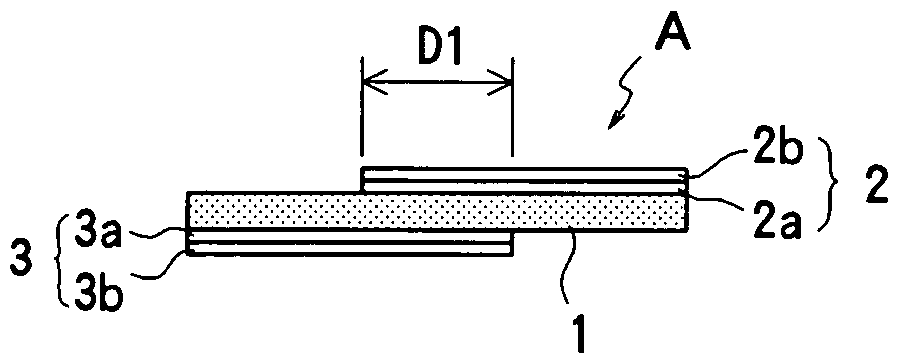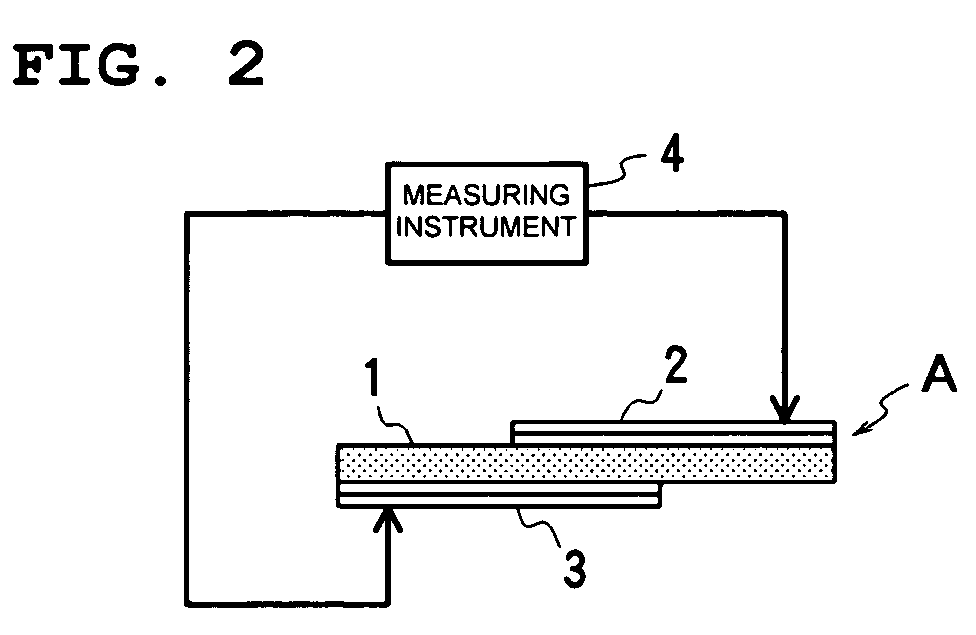Method for manufacturing piezoelectric resonator
a piezoelectric resonator and manufacturing method technology, applied in the direction of piezoelectric/electrostrictive transducers, generators/motors, transducer types, etc., can solve the problems of low frequency concentration, inability to accurately adjust the frequency, and difficulty in accurately positioning the etching resist ink or the metallic mask
- Summary
- Abstract
- Description
- Claims
- Application Information
AI Technical Summary
Benefits of technology
Problems solved by technology
Method used
Image
Examples
first preferred embodiment
[0051]A manufacturing process of a piezoelectric resonator according to a first preferred embodiment of the present invention is shown in FIGS. 1A through 4B. The piezoelectric resonator of this preferred embodiment is a bi-terminal resonator.
[0052]In FIGS. 1A and 1B, a resonator A in the first stage of the manufacturing process is shown. The resonator A includes a substantially rectangular piezoelectric substrate 1, and first electrodes 2 and 3 are respectively formed on the obverse and reverse surfaces of the piezoelectric substrate 1. The resonator A is preferably an energy-trap thickness-shear vibration mode resonator, and polarization has been performed on the obverse and reverse surfaces of the piezoelectric substrate 1 in the parallel direction. One end of the first electrode 2 and one end of the first electrode 3 oppose each other at an approximately central portion of the piezoelectric substrate 1, and the other ends thereof are led out to different terminals. An opposing p...
second preferred embodiment
[0063]A manufacturing process of a piezoelectric resonator according to a second preferred embodiment of the present invention is shown in FIGS. 5A through 8C. The piezoelectric substrate of this preferred embodiment is preferably a tri-terminal filter. FIGS. 5A, 5B, and 6 are similar to FIGS. 1A, 1B, and 2, respectively, and elements in FIGS. 5A, 5B, and 6 similar to those in FIGS. 1A, 1B, and 2 are indicated by like reference numerals, and an explanation thereof is thus omitted.
[0064]FIGS. 7A and 7B illustrate a resonator B1 in the second stage. On the obverse surface of the resonator B1, a second electrode 20 is formed from the opposing portion D1 of the resonator A of the first stage to the end of the piezoelectric substrate 1 opposite to the side on which the first electrode 2 is disposed. On the reverse surface of the resonator B1, a second electrode 21 is formed from the opposing portion D1 of the resonator A of the first stage to the end of the piezoelectric substrate 1 oppo...
third preferred embodiment
[0071]A manufacturing process of a piezoelectric resonator according to a third preferred embodiment of the present invention is shown in FIGS. 9A through 12C. The piezoelectric resonator is preferably a two-stage double-mode filter obtained by forming two tri-terminal filters on a single piezoelectric substrate.
[0072]FIGS. 9A and 9B illustrate a resonator A2 in the first stage. The resonator A2 includes a substantially rectangular piezoelectric substrate 31, and polarization has been performed on the obverse and reverse surfaces of the piezoelectric substrate 1 in the parallel direction. A first electrode 32 is formed at an approximately central portion of the obverse surface of the piezoelectric substrate 31, while first electrodes 33 and 34 are formed at two ends of the reverse surface of the piezoelectric substrate 31. The first electrode 32 on the obverse surface opposes the first electrodes 33 and 34 on the reverse surface at the two portions of the piezoelectric substrate 31....
PUM
| Property | Measurement | Unit |
|---|---|---|
| frequency | aaaaa | aaaaa |
| thickness | aaaaa | aaaaa |
| resonant frequency | aaaaa | aaaaa |
Abstract
Description
Claims
Application Information
 Login to View More
Login to View More - R&D
- Intellectual Property
- Life Sciences
- Materials
- Tech Scout
- Unparalleled Data Quality
- Higher Quality Content
- 60% Fewer Hallucinations
Browse by: Latest US Patents, China's latest patents, Technical Efficacy Thesaurus, Application Domain, Technology Topic, Popular Technical Reports.
© 2025 PatSnap. All rights reserved.Legal|Privacy policy|Modern Slavery Act Transparency Statement|Sitemap|About US| Contact US: help@patsnap.com



